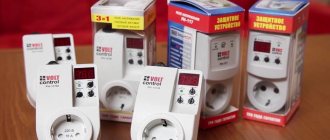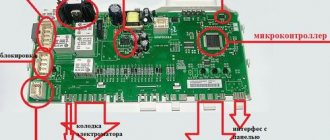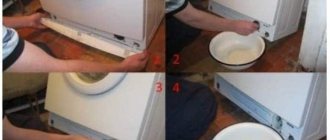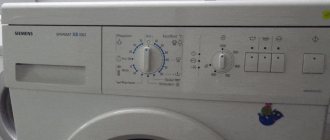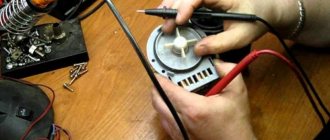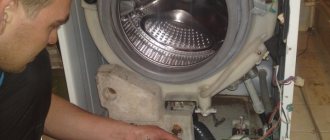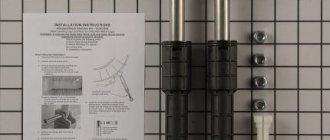Reasons for a non-working centrifuge
There are several reasons that cause the problem :
- Damage to the safety sensor.
- Brake pads.
- There is a problem with the timer.
- Damage to the electrical winding.
- Other causes of malfunctions.
Damage to the safety sensor
Some models, such as Daewoo or Saturn, have a sensor on the door that closes the centrifuge tank. It is needed to disable startup. To get to it, you will need to remove the top panel of the washing machine - under it there is a sensor with 2 contacts that need to be treated with a cotton swab dipped in alcohol. There is no need to scratch the contacts with a knife or clean them with sandpaper. Then you need to check the operation of the sensor. The contacts must close when the cover is closed.
Brake pads
What is the principle of braking in semi-automatic cars?
The brake pads are installed under the centrifuge, and thus slow it down when opening.
The pads are connected to the cover using a cable. When the lid is opened, the cable is tensioned and
The pads fit around the part of the engine that rotates. Thus, the centrifuge stops.
It is necessary to open the rear wall of the brake pad and check how the cable is tensioned so that the pads do not touch the engine when the door is closed, since touching the brake pads may prevent the electric motor from starting.
Timer fault
In most semi-automatic washing machines (SMP), the timer is located under the top panel of the device. It can be repaired by cleaning the contacts.
There are many tips on how to remove the panel, since washing machines from different companies are designed differently.
Once you remove the top panel, you will notice a device that resembles a clock with gears.
There are contacts inside this device that can burn out over a long period of use. The reason is soot, which does not allow current to pass through.
It is necessary to disassemble the timer very carefully, since the cover of this mechanism also serves to attach gears to it. After unscrewing all the screws, you need to remove it in such a way that the gear wheels do not fall out when opening. If you're worried that you won't be able to open the lid carefully, then it's better to play it safe and take a photo of the entire mechanism. After removing the cover you will notice the contacts. They need to be wiped with alcohol, just like in the sensor.
Damage to the electrical winding
Very often, the burnout of one of the windings of the electric motor is the cause of its breakdown.
This can be checked using a tester, that is, a measuring device. Here are three steps on how to do it.
- First, we find the ends of the wires that come out of the electric motor. Usually there are three wires: the first is common, the second is the one that leads to the starting winding, and the third leads to the working winding. Usually the common wire is marked with the letter “N” and is blue.
- You need to set the resistance test on the device, and measure it between the common wire and one of the other two, for example, red. If the resistance readings of the device are present on the screen, then everything is in order with this winding.
- We do the same with another pair, with a common and, say, white wire. Then we measure the resistance and note the readings of the device. If there is no resistance, then this means that the winding has burned out. That is, the reason that the centrifuge in your semi-automatic machine does not work is a malfunction of the electric motor.
In this case, there are two options: buy and install a new motor or recycle the old one.
Debugg
If, when you turn the switch to the drying/spin mode, the machine does not start working or does it unnaturally (with a hum or strong vibrations), and the laundry remains wet, you should look for the reason in the incorrect operation of the centrifuge . This could be due to a number of factors:
- protective sensor failures;
- timer failure;
- jamming of brake pads;
- violation of the integrity of the electrical winding.
Important! The above cases require immediate elimination of the problem by partially disassembling the device.
Safety sensor
Most modern semi-automatic machines are equipped with a special switch that stops the engine while the centrifuge is running, when the lid covering it opens. This is done for security reasons. When this sensor gets stuck in the open position of the door, the spin simply does not start. Failures may occur due to contamination of the contacts. To fix the problem, just clean them with cotton wool soaked in alcohol. You can get to the sensor by removing the top panel of the washing machine.
Timer
Just as with the safety switch, the timer is often located under the top cover of the device. It looks like a clock mechanism with gears, hidden under a transparent plastic cover. It is secured with three screws that need to be removed. Under it, among the gears, there are also contacts. Due to prolonged use, carbon deposits may form on them due to intense engine operation. Because of this, no current pulses are received and the centrifuge drum does not spin. The method for solving the problem is similar to the previous one - cotton wool and alcohol.
Advice! When repairing the timer, be careful not to let the gears fall apart. To prevent such a situation, it is recommended to record their location in the photo. Otherwise, incorrect assembly may lead to new damage.
Brake pads
If you open the lid while the washing machine is operating, the protection system will work and the drum will gradually stop. This is ensured by the presence of brake pads located under the centrifuge. The operating mechanism is based on the tension of the cable connecting the pads to the cover. When it is in the open position, the cable is tensioned and the brake pads clamp the rotating element of the engine. This is how braking occurs.
The cable may get stuck or caught on another part, thereby actuating the braking system and preventing the engine from starting and, therefore, starting the centrifuge. To change the position of the pads, you need to open the back cover of the washing machine and check the tension of the cable when the cover is closed.
Motor winding
In cases where the centrifuge drum in the SMP does not gain speed, the reason should be sought in the motor, or more precisely, in its winding. To do this, use a multimeter to measure the resistance on the motor. Depending on what the indicators on the device are, the nature of the malfunction will become clear: a break (as well as burnout) of the wiring or a short circuit. Based on the data obtained, a method for eliminating the problem is determined.
To diagnose the condition of the winding, it is necessary to “ring” the wiring for resistance. Typically, three wires come out of the electric motor: common, for the starting and for the working winding. But to obtain more accurate information about the structure of the unit, it is recommended that you familiarize yourself with the electrical diagram, which is usually located inside the washing machine body (on one of its walls). The tester probes are applied to two different wires. If the readings on the device fluctuate between 20 and 200 Ohms, then everything is normal. When the value is less, this indicates a short circuit, and when it is more, it indicates a wire break. In the latter case, you can send the component for rewinding or purchase a new one.
Other reasons
In addition to the listed breakdowns, there are others that can disrupt the operation of the spin cycle. Often you can fix them yourself without resorting to disassembly. Among the most common causes of centrifuge malfunction are the following:
- The belt that connects the centrifuge to the engine pulleys has broken or fallen off. A breakdown can be recognized if the machine hums, but does not spin the drum.
- The laundry is unevenly distributed, causing the centrifuge to wobble but cannot start.
- Small objects getting on the motor shaft. This can happen during the spin cycle. To make everything work again, it is enough to remove foreign objects from the surface of the part.
If the spin system motor works, but things remain wet, then the reason may lie in a malfunction of the drain system. For example, an incorrectly installed hose can cause the machine to simply not drain the water squeezed out of things.
Why centrifuge breakdowns happen most often
The centrifuge in a semi-automatic washing machine can rightfully be considered the weakest part of the design. This unit is made as simple as possible. The tank is directly connected to the motor shaft. Only the seal protects against short circuits due to water ingress. It is attached to the tank and is subject to constant wear and tear.
The oil seal fails not only due to frequent use of the wringer. It can deteriorate when the device is idle. That is, the rubber becomes rougher, and when it dries out, cracks form on it. As a result, leaks occur, which can result in a short circuit of the engine.
There is one important detail here. If such a breakdown occurs, it is not only the drive that needs to be replaced. A new oil seal will have to be installed along with the engine. This is the only way to protect against leaks and repeated breakdowns.
Oil seal for semi-automatic washing machine
There are similar problems in other components of the semi-automatic machine. And we can confidently say that they arise due to a simplified design. For example, there are difficulties with draining water. For the simple reason, there is no filter at the pump inlet, and the valve cannot cope with a large amount of contaminants. There are also difficulties in the operation of the washing unit. In particular, the gearbox may fail due to leaks in a worn oil seal.
What to check first if the washing machine does not pick up speed?
- Check which washing program you have selected . Perhaps low revs are a feature of this particular program. For example, for wool and delicate fabrics, all machines specially reduce speed - this helps to avoid deformation of things.
- Check the spin speed switch: many machines allow you to manually adjust the number of revolutions per minute. Maybe you accidentally touched the spin speed button/control and it “jumped” to a reduced mode?
If everything is in order with the program selection, but the machine still does not accelerate, then interrupt the washing cycle or wait until it ends and remove the laundry. “Estimate” the approximate load weight. Perhaps this is the problem:
- may have overloaded the washing machine. If there is too much laundry, try dividing it into two loads and running the spin cycle again.
- Or, on the contrary, they put too few things. In this case, experienced housewives advise putting a clean terry towel in the drum along with under-wrung laundry.
- Unbalanced laundry is also a common reason why the machine cannot get up to speed. For example, when duvet covers “eat up” all other things. In this case, simply distribute the laundry evenly across the drum and try running the spin cycle again.
If everything is fine with the choice of program, and the weight and distribution of the laundry in the drum do not cause any complaints, then, alas, something is broken in the machine.
Why does the centrifuge in the washing machine not pick up speed?
The washing machine is the main friend and helper of every family. Breakdowns are not excluded, the main thing is to take timely measures. provides a full range of services to Moscow residents. Repairs are carried out by specialists with at least 5 years of experience, so the work is carried out at a high level. We leave on the day of your request or at any convenient time. Repair of washing machines is carried out with a guarantee - the client receives a receipt for the work performed and within the specified period can apply to have the problem resolved. Diagnostics are free.
Why doesn't the centrifuge drum spin?
The centrifuge drum most often does not spin or does so slowly for two reasons.
- The engine starting capacitor is broken, dried out, or otherwise damaged.
- The brake cable has become loose.
The capacitor can only be checked with a special device. Therefore, the easiest way is to replace this element with a new one with a rated capacity. An indicator that such repairs need to be made looks like a strained, leisurely start. The set of revolutions is slow, and the tank does not spin up to the set rotation speed.
Diagram of a semi-automatic washing machine with a centrifuge
The cable is checked by rotating the drum. To do this, close the lid or close the control limit switch. Then you need to try to turn the centrifuge drum. If it turns with force, it is necessary to restore the cable tension.
When both checks fail, you should carefully inspect the drum. If there are streaks on it, most likely moisture has entered the engine. This means that the drive needs to be replaced. And don't forget to install a new oil seal. If the drum is visually clean, you should move on to checking the contacts. Unfortunately, many manufacturers offer unreliable connection options. And the wiring tends to oxidize.
How to dismantle the activator?
If you have to work with a Soviet semi-automatic machine, for example, the Malyutka or Saturn brand, then removing the activator with your own hands will not be entirely easy. Before starting disassembly, it is recommended to make a key. A homemade tool will make dismantling the unit much easier.
Finding a key for removing the activator from Soviet cars on sale is almost impossible. Each semi-automatic machine needs its own tool. It is not difficult to make an individual device for dismantling; the work will take 10-15 minutes.
For example, to make a key for the Malyutka activator washing machine, you will need:
- metal tube (its length should be 15 cm greater than the size of the activator disk);
- drill;
- two bolts and nuts for them.
To make a key, follow these steps:
- drill 2 holes on the pipe, making them at a distance of 9.5 cm;
- insert the screws into the drilled holes so that the screws stick out 1-2 cm on the other side;
- secure the bolts with nuts.
This will be the key that will make it easier to remove the activator. The further algorithm of actions is as follows:
- turn off the power to the semi-automatic machine;
- pull out the plug on the side of the device;
- rotate the activator disk so that the holes on the impeller and the housing panel are at the same level;
- block the motor rotor with a screwdriver;
- insert the designed key into the activator and dismantle the element.
Which direction to turn the activator disk will depend on the SMP model.
Owners of “Fairy” and “Ivushka” washing machines and “Mini-Vyatka” semi-automatic machines will also have to work hard when removing the activator. In these semi-automatic machines, the disc is driven by a drive belt, as on automatic machines with a commutator motor. In this situation, the sequence of actions will be as follows:
- de-energize the device;
- loosen the fasteners securing the engine;
- remove the drive belt from the pulley;
- twist the nut that secures the pulley;
- remove the stopper;
- pull out the activator.
If you change the activator, then when installing a new one, make sure that the distance between it and the tank does not exceed 2 mm.
In order for a semi-automatic machine to operate normally after installing a new activator, it is important to correctly adjust the element. The disk can be shifted along its axis by no more than 0.5 mm; the distance between it and the tank should not exceed 2 mm.
If you find a long-forgotten activator machine in the garage, do not rush to throw away the device. Having disassembled the washing machine, you can dismantle several useful parts for the household. For example, a motor from a semi-automatic machine can be used for various “homemade products” - a lathe, a crusher, etc.
Interesting:
- Why does the spin cycle in a semi-automatic washing machine not work?
- What is the difference between an automatic washing machine and a semi-automatic one?
- What is an activator washing machine?
- What can be done from an old washing machine
- The best activator washing machines
- How to disassemble a Zanussi washing machine
Reader comments
- Share your opinion - leave a comment
How to disassemble the machine
Semi-automatic machines are almost like two peas in a pod. Of course, if we consider the key design features and methods of arranging components inside the case. Therefore, a person who has successfully disassembled and reassembled one machine can, with a high probability, correctly carry out the same work on another.
The general algorithm of actions looks like this.
- Remove bolts and screws from the entire body of the device. Finding them can be quite difficult. Many manufacturers place mounting points deep within the body. Therefore, it doesn’t hurt to stock up on a long screwdriver.
- Disconnect the centrifuge drum brake units and the water drain valve. To access them there is a hole in the rear of the machine.
- Unlock the centrifuge shaft.
It is worth dwelling on the last operation in more detail. The shaft bolt is secured with a locknut. To work, you will need a simple socket wrench. The nut is loosened, after which the bolt can be removed. At the end of this operation, it is necessary to fold back the entire upper part of the housing. This will have to be done with effort. To avoid damaging anything, it is recommended to pull with a rocking motion to release stubborn elements or corroded surfaces.
Disassembling a semi-automatic washing machine
In general, semi-automatic washing machines are fairly unified devices and differ little from each other in terms of filling. Therefore, having experience in disassembling a machine of one brand, it will not be difficult to disassemble a similar one from another manufacturer. Standard steps for disassembling semi-automatic machines fit into the following algorithm.
- Unscrew the bolts located in a circular pattern around the body of the washer. But some fasteners are in deep sockets on the bottom of the equipment, which can only be reached with a long screwdriver of 150 mm.
- Disconnect the centrifuge valve and brake through the hole in the rear panel of the housing.
- Unscrew the bolt on the centrifuge shaft, for which you will need a socket wrench: first you need to loosen the lock nut, and then the bolt itself.
- Next, you need to tilt the upper part of the machine body back, after shaking it to free the stuck parts. That's it - the equipment is ready for repair.
However, due to certain design decisions, disassembly methods differ among some manufacturers. So, in order to unscrew the nut from the centrifuge tank when dismantling the engine in SMP Siberia, you need to make your own wrench, the basis of which is a three-quarter-inch pipe. For SMP models from Saturn and Fairy, when removing the top panel, you need to unscrew the bolt located on the back wall of the device and remove it by moving it sideways. Users of semi-automatic machines such as Daewoo, Candy and Krista KR often have difficulty removing this panel, since the screw securing it is hidden under a plastic plug.
Design of the Sibir-5M washing machine
For many domestic machines such as Slavda (also produced under the name Renova) or Assol, the problem is replacing the activator. Sometimes it is not enough to remove the bolt and pull the part towards you: often it is simply impossible to hook it due to the rounded edges and smooth plastic. To remove the activator in such machines, you can screw two self-tapping screws opposite each other into its holes and, holding their heads, remove the element.
Advice! To work with the electrical components of the device, it is preferable to be guided by the circuit diagram located inside the case, since the arrangement of elements in individual models may differ.
The most common breakdowns in which the washing machine does not pick up speed
The rotation speed of the drum depends on many components in the washing machine. Therefore, only a specialist can determine on their own what exactly is responsible for the fact that the machine does not want to gain the required speed.
| Breaking | What is the problem |
| Malfunction of the water level sensor (pressostat) | The water sensor has failed , which in normal condition tells the control module what the water level is in the machine. Based on these data, the “brain” of the washing machine turns on draining or spinning. If the sensor thinks that there is still water left in the machine, the spin cycle will not actually start: the machine will try to drain the non-existent water. In this case, the speed will be significantly lower than during spinning. The sensor needs to be replaced. |
| Malfunction of the tachometer (speed control sensor) | Failure of the tachometer - the unit that controls the speed of the washing machine - leads to the machine losing control over the speed and not giving the command to accelerate the drum. The sensor needs to be replaced. |
| Malfunction of the “brain” of the washing machine: the electronic module (in devices with electronic control) or the programmer (in models with electromechanical control) | Failures in the control board lead to the fact that the washing machine does not give the correct commands to other components of the unit - in our case, the spin cycle does not turn on at the required speed. The board needs to be re-flashed or replaced. |
| Washing machine motor malfunction | The motor—the physical driving force of the drum—has broken down. As a rule, most often the reason lies in an interturn short circuit: in this case, the engine runs, but only at half power. It has enough power to rotate the drum at low speeds - during washing and draining, but it is not possible to accelerate the drum to the specified speed for spinning. Also, wear on the graphite brushes of the motor can lead to insufficient rotation. The engine needs to be inspected, repaired or replaced. |
| Drive belt failure | Abrasion and deformation of the drive belt leads to the fact that the traction weakens, and at high speeds it spins “idle”. Because of this, the overall rotation speed of the machine drum is significantly reduced and does not reach the set speed. The drive belt needs to be replaced. |
In addition to the above cases, sometimes the problem lies in the fact that for some reason the machine cannot drain the water: in this case, there is also no need to talk about spinning. If you find that the machine not only does not develop the required speed, but also does not drain the water, refer to our article “Washing machine does not drain water”.
However, with or without water - if you find that your washing machine is not picking up speed - you should not put up with spinning it manually.
Why doesn't the spin cycle work in an automatic washing machine?
The fact that the equipment is not working correctly is indicated not only by its stopping instead of the spin mode specified and the program freezing. Also factors indicating a malfunction of the “washer” are:
- after the cycle was completed, things remained damp;
- After you take your laundry out of the spinner, there is still water left in it.
Various reasons can lead to such violations. But before calling a specialist from a service workshop, try to fix the problem yourself. To do this, you need to find out the reason that led to the breakdown. The most common are:
- Centrifuge imbalance. Things in the drum should be distributed evenly over the entire surface. Otherwise, an imbalance occurs. In this case, the device will report an error or the centrifuge will simply stop rotating. To fix the problem, just open the loading hatch door and spread things out evenly.
- The wrong wash cycle is being used. Spin is the last stage; it completes the entire washing cycle. However, not all modes include this feature. In some it occurs at minimum speed, while other programs only involve draining water. This is typical for the following modes: delicate, silk, wool, thin fabrics, gentle and a number of others. Also, pay attention to whether the No Spin function is turned on. Then it will be enough to wait for the process to complete and additionally enable the “Spin” option.
- Household appliances are overloaded. Manufacturers indicate the maximum permissible weight of laundry, so it is important to follow these recommendations. If you ignore the advice, a failure will occur during the process, an error message will appear on the display, or the unit will stop washing altogether. It's easy to deal with the problem - open the door and take out the extra items. However, it is better not to allow a malfunction to occur and not to overload the drum.
- The laundry is unevenly distributed. Like overload, underweight laundry also has a negative impact on household appliances. If you put a small amount of things, during the process they will bunch up into one lump. Modern models of “washing machines” are equipped with special sensors that determine the uniformity of the load. This helps protect equipment from serious damage. If the sensors detect a lump of laundry, the unit will start spinning at minimum speed or completely complete the wash by draining the water from the drum.
- The pressure switch has failed. Pressostat is a sensor that determines the amount of water inside the centrifuge. It notifies the central module about the presence or absence of liquid. After which the system launches the corresponding program. If the information is not received, then the mode does not start.
- Engine malfunction. In most cases, spinning occurs at maximum centrifuge speed. If the engine fails, the first manifestation of the failure will be incorrect completion of the cycle. The cause of the malfunction may be wear on the rotor brushes or broken wiring. This can only be diagnosed by disassembling the device body and inspecting the damaged elements.
- Incorrect operation of the tachometer. The device installed on the shaft of the machine is responsible for the number of revolutions of the centrifuge. If it fails, the central board does not receive this information and does not start the spin mode.
- Central module malfunction. This is the “brain” of the unit. It regulates the entire washing process, launching the necessary modes. If the board fails, problems can arise at any stage of the wash.
- Drain pump. During operation, the part becomes clogged with various dirt, so the machine cannot drain the water correctly and start spinning.
Reference. In some cases, an imbalance in the centrifuge is caused by a bulky item that becomes even heavier when wet. Therefore, it is necessary to correctly estimate the weight of laundry to be washed.
Other causes of centrifuge malfunctions in semi-automatic machines
It is very difficult to list all the reasons for breakdowns of the spin system. Different car models have their own nuances. However, if you can repair it yourself, you will save a lot of money.
Let's look at the most common causes of malfunction of the spin system .
- The motor hums loudly, but the spin does not start. This means that the belt that connects the centrifuge and motor pulleys has broken or slipped off.
- During long-term operation of the machine, the rubber diaphragm bushing may wear out . A large gap between the parts will prevent the spin cycle from starting. To make the machine work, the bushing needs to be replaced.
- If you checked the electric motor and made sure that it is working, then the reason may be a faulty thermal relay , or a step-down transformer. These parts cannot be repaired and must be replaced with new ones.
- It would also be a good idea to check whether small things are wrapped around the electric motor shaft . They may fly out during the spin cycle and end up in the middle of the machine.
- Laundry placed unevenly inside the centrifuge can cause it to wobble and prevent it from starting.
- If the activator spin motors do not work, it would be a good idea to check the fuse , which is located in the middle of the machine behind the rear panel. You can also check the electrical plug (contacts).
A semi-automatic washing machine cannot be called a simple mechanism. Therefore, some types of malfunctions can only be corrected
master
.
However, if you carefully follow our advice, carry out the necessary actions carefully and without haste, then you will be able to repair your washing machine yourself, without outside help. This is especially true for repairing a centrifuge in a semi-automatic washing machine.
TOP stores of washing machines and household appliances:
- mvideo.ru / - household appliances store, large catalog of washing machines
- holodilnik.ru – Inexpensive store of household appliances.
- techport.ru – profitable modern online store of household appliances
- citilink.ru is a modern online store of household appliances and electronics, cheaper than offline stores!
- ru.aliexpress.com – spare parts for washing machines
( 2 ratings, average 4.5 out of 5 )
What kind of breakdowns happen?
A semi-automatic washing machine is considered simpler, but nevertheless it has an impressive list of possible breakdowns. This is ensured by a specific design. If a semi-automatic machine is not working, it could be due to a number of reasons.
Engine does not start during spin cycle
A failure can be caused by burnt contacts or broken wiring powering the electric motor. The timer, temperature sensor or motor could be broken; capacitor or relay responsible for starting the engine. Transformer failure cannot be ruled out.
And worn brushes are the cause of motor failure in every second semi-automatic type SM. In this case, disassembly and repair of the motor are required, accompanied by replacement of the brushes.
The engine is working fine, the centrifuge does not spin
If the SM with a centrifuge does not spin, but the engine works, it is not a fact that this is a breakdown. You may have overloaded the tank with wet laundry. But the brake blocking the drum may also malfunction.
The drum may also jam due to too much water or debris, small objects, or laundry getting into the tank. Then there is no need for repairs - just disassemble the tank and remove the foreign body.
The engine works, but the drum does not spin (Slavda)
Probable reasons for such a failure of the Slavda brand SM:
- The laundry is bunched up and lies on one side, causing the rotor to swing and hit the tank. This blocks the spin and operation of the machine.
- With a long service life, the bushings could wear out. If they are broken, the rotor does not spin as expected - repair is required.
- The drive belt has slipped or broken. You need to put the unit back in place or replace it.
The machine leaks when spinning
Let's name 8 reasons for this failure:
- The tank is damaged and leaking.
- Fasteners have broken or stretched, or the connections between hoses and centrifuge parts have become loose. The weak point is the connection of the hoses to the pump or tank.
- The diaphragm has failed or its fastenings have been damaged.
- The cuff on the drain valve has dried out or torn.
- The drain pump housing is damaged.
- The water drain valve mechanism is broken.
- The pipe or hose is damaged.
- The lid seals on the drain pump are damaged, so the pump leaks water.
The pump drains poorly or does not work at all
Reasons for drain failure: clogged drain hose or pump. You shouldn’t rule out a breakdown of the impeller - when it happens, the water drainage first slows down and then disappears.
The machine can retain water for a long time due to mechanical reasons that are not breakdowns:
- Laundry accidentally fell into the drain hole of the centrifuge.
- The water drain hose is kinked or pinched.
Water flows from one tank to another
If water “migrates” from the wash tub into the spin tank, then the overflow hole has failed. A more accurate reason is the wear of the valve rubber, due to which water is not retained in the drum. You can't do without repairs.
The semi-automatic machine does not turn on
When the SM does not start, the reason must be sought in the electrics - it could be a breakdown of the plug, power cord or relay. Often a failure occurs when the motor fails. Maintenance and electrical repairs and engine inspection are required.
Important! This is not a complete list of malfunctions of semi-automatic machines. But often the problems are superficial and are not breakdowns. Thus, a failure of the level sensor can be eliminated by straightening the pinched drain hose.
Foam comes out of the washing machine
There is such an incident. Any housewife who washes tulle curtains in a washing machine has encountered it at least once. Excessive foaming of the fabric structure occurs. It becomes crowded in the tank and it begins to leak out of the technical holes. In this case, there is no reason to worry.
After a wash cycle, is there a puddle of water under the machine? The cause may be a worn gasket in the water supply hose. You can deal with it yourself. There are several other reasons for leakage: damage to the pipe or cuff of the hatch, and damage to the drum. With such breakdowns you will need to contact a specialist.



